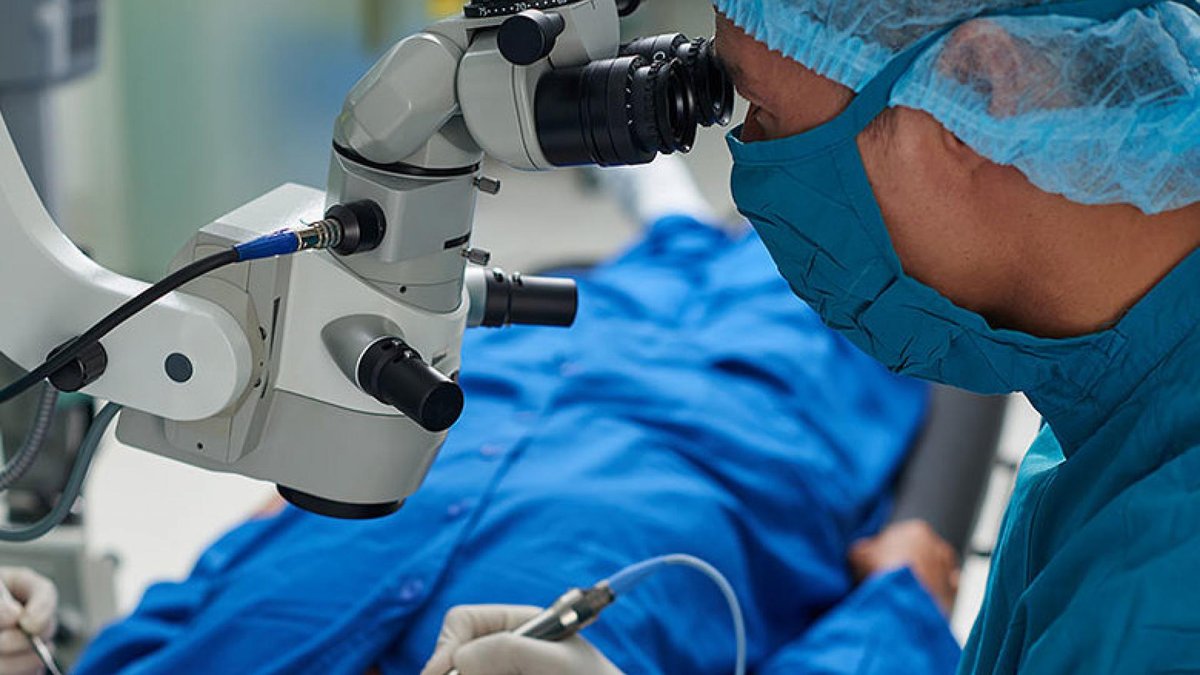
This article explores the potential risks of glaucoma surgery and explains why the benefits outweigh risks for most advanced cases.
Glaucoma Treatments
Glaucoma is a chronic, progressive deterioration of the optic nerve. (The optic nerve is the bundle of nerve fibers at the back of the eye that carry visual messages from the retina to the brain). Glaucoma is usually caused by or worsened by pressure inside the eye (intraocular pressure, or IOP) that is too high for the continued health of the nerve.
The only proven treatment for glaucoma involves lowering eye pressure in order to prevent or to slow down the damage to the optic nerve.
Glaucoma Surgeries
Glaucoma surgeries include the delicate, microscopic incisional trabeculectomy (with or without ExPRESS microshunt implantation), tube shunt implantation (a shunt is a glaucoma drainage device), and cyclophotocoagulation . There are also newer procedures called MIGS, or minimally invasive glaucoma surgery . Each type of glaucoma surgery has its unique uses, advantages and disadvantages.When considering glaucoma surgery, you should have a detailed discussion with your surgeon about the risks and benefits of the specific surgery you may undergo.
When considering glaucoma surgery, you should have a detailed discussion with your surgeon about the risks and benefits of the specific surgery you may undergo. In this article, we will discuss the risks and benefits of glaucoma surgery in general.
Benefits vs. Risks of Surgical Treatment
As with any operation, there are risks associated with glaucoma surgery. This article discusses different risks so you can have an open dialogue with your eye surgeon (ophthalmologist). It’s important to note, however, that surgery has very high success rates in substantially slowing the progression of glaucoma. When it comes to surgical intervention for advanced glaucoma cases, the benefits typically outweigh the risks. The following are (rare) glaucoma surgery risks or side effects to discuss with your doctor:
- Vision loss
- Bleeding in the eye
- Infection
- Low eye pressure (or hypotony)
- Scarring
- Cataract formation
Below we discuss each of the risks and why we believe the benefits outweigh them.
Vision Loss
In the short term after your operation, glaucoma surgery temporarily disrupts your vision. It is important to understand that permanent vision can be reduced, or even, in very rare instances, totally lost as a result of any of these glaucoma operations; however, vision loss is not a common permanent side effect. Therefore, it is more likely that surgery will benefit your vision in the long run.
Bleeding
With any of these operations, complications can occur even with the best surgical techniques. Uncommon or rare complications include bleeding inside the eye, infection, and fluid pockets behind the retina due to very low eye pressures. Bleeding inside the eye can be a very serious complication, so you should talk with your ophthalmologist if you are on blood thinners and follow his/her instructions about continuing or discontinuing the medication prior to surgery.
Infection
Eye doctors give antibiotics before, during, and after the surgery, as well as maintain meticulous sterile techniques to try and avoid any infection. However, on very rare occasions, infection inside the eye may occur, which can be very serious and may threaten vision. These infections can occur weeks, months, or even years after the surgery. Therefore, even if it is years after the surgery, if you have early signs of infection such as redness, pain, or excessive tearing, you should call and see your ophthalmologist immediately in order to treat infection before it becomes serious. Caught early, most infections can be adequately treated with antibiotic drops.
Low Eye Pressure
Sometimes, the surgery can lead to eye pressures that are too low, also called hypotony. This is more common soon after the surgery. With hypotony, fluid may collect behind the retina (choroidal detachment), which can cause a shadow in your peripheral or side vision. Usually this is temporary as the pressure returns to the levels that were intended. Sometimes, however, hypotony persists and surgery must be performed in order to fix this problem.
Scarring
More common than eye pressure that is too low, these glaucoma surgeries may fail over time due to the natural healing or scarring tendencies of the eye, resulting in eye pressures that are higher than intended. Sometimes, the scarring is so intense that the operation may fail to achieve a lowered pressure and you may need to restart your glaucoma medications or undergo revisions in the clinic or repeat surgery in the operating room.
Cataract
Cataract formation most likely will be accelerated by glaucoma surgery, but luckily cataracts are fairly easy to fix surgically. Sometimes glaucoma surgeries are combined with cataract surgery if your ophthalmologist feels that the cataracts are having a moderate to significant impact on your vision. However, for some glaucoma surgeries it is better to perform the glaucoma surgery alone and address the cataract later in a second operation.
Safer Procedures on the Horizon
MIGS (minimally invasive glaucoma surgery) are a group of newer procedures that are usually combined with cataract surgery to lower eye pressure to the mid-teens range. In most instances, the safety profile of these procedures is higher than the more traditional glaucoma surgeries described above. However, this enhanced safety profile is counterbalanced by a more modest eye pressure reduction. Therefore, these procedures are usually combined with cataract surgery for patients with early- to moderate-stage glaucoma. For patients with advanced glaucoma, the MIGS procedures are less likely to achieve the low eye pressures needed.
Conclusion
Although glaucoma surgery can prevent further vision loss and on rare occasions even improve vision, damage that has already occurred due to glaucoma is considered permanent and not yet reversible via medication, laser surgery, eye stents, or MIGS. While it is important to understand the risks discussed above, many of which are rare, it is also important to recognize that the vast majority of glaucoma surgeries are successful at slowing the progression of glaucoma and achieving the intended eye pressure. Therefore, we advise working with your ophthalmologist to explore options when the time is right and not delay treatment unnecessarily.










